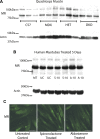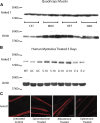Mineralocorticoid receptors are present in skeletal muscle and represent a potential therapeutic target
- PMID: 26178166
- PMCID: PMC4608910
- DOI: 10.1096/fj.15-276782
Mineralocorticoid receptors are present in skeletal muscle and represent a potential therapeutic target
Abstract
Early treatment with heart failure drugs lisinopril and spironolactone improves skeletal muscle pathology in Duchenne muscular dystrophy (DMD) mouse models. The angiotensin converting enzyme inhibitor lisinopril and mineralocorticoid receptor (MR) antagonist spironolactone indirectly and directly target MR. The presence and function of MR in skeletal muscle have not been explored. MR mRNA and protein are present in all tested skeletal muscles from both wild-type mice and DMD mouse models. MR expression is cell autonomous in both undifferentiated myoblasts and differentiated myotubes from mouse and human skeletal muscle cultures. To test for MR function in skeletal muscle, global gene expression analysis was conducted on human myotubes treated with MR agonist (aldosterone; EC50 1.3 nM) or antagonist (spironolactone; IC50 1.6 nM), and 53 gene expression differences were identified. Five differences were conserved in quadriceps muscles from dystrophic mice treated with spironolactone plus lisinopril (IC50 0.1 nM) compared with untreated controls. Genes down-regulated more than 2-fold by MR antagonism included FOS, ANKRD1, and GADD45B, with known roles in skeletal muscle, in addition to NPR3 and SERPINA3, bona fide targets of MR in other tissues. MR is a novel drug target in skeletal muscle and use of clinically safe antagonists may be beneficial for muscle diseases.
Keywords: aldosterone; gene expression microarray; muscular dystrophy; spironolactone; steroid hormone receptors.
© FASEB.
Figures





Similar articles
-
Renin-angiotensin-aldosterone system inhibitors improve membrane stability and change gene-expression profiles in dystrophic skeletal muscles.Am J Physiol Cell Physiol. 2017 Feb 1;312(2):C155-C168. doi: 10.1152/ajpcell.00269.2016. Epub 2016 Nov 23. Am J Physiol Cell Physiol. 2017. PMID: 27881412 Free PMC article.
-
Similar efficacy from specific and non-specific mineralocorticoid receptor antagonist treatment of muscular dystrophy mice.J Neuromuscul Dis. 2016;3(3):395-404. doi: 10.3233/JND-160173. J Neuromuscul Dis. 2016. PMID: 27822449 Free PMC article.
-
Gene expression effects of glucocorticoid and mineralocorticoid receptor agonists and antagonists on normal human skeletal muscle.Physiol Genomics. 2017 Jun 1;49(6):277-286. doi: 10.1152/physiolgenomics.00128.2016. Epub 2017 Apr 21. Physiol Genomics. 2017. PMID: 28432191 Free PMC article.
-
Mineralocorticoid Receptor Signaling in the Inflammatory Skeletal Muscle Microenvironments of Muscular Dystrophy and Acute Injury.Front Pharmacol. 2022 Jun 28;13:942660. doi: 10.3389/fphar.2022.942660. eCollection 2022. Front Pharmacol. 2022. PMID: 35837290 Free PMC article. Review.
-
Mineralocorticoid receptor antagonists: the evolution of utility and pharmacology.Kidney Int. 2000 Apr;57(4):1408-11. doi: 10.1046/j.1523-1755.2000.00983.x. Kidney Int. 2000. PMID: 10760075 Review.
Cited by
-
Spironolactone inhibits the growth of cancer stem cells by impairing DNA damage response.Oncogene. 2019 Apr;38(17):3103-3118. doi: 10.1038/s41388-018-0654-9. Epub 2019 Jan 8. Oncogene. 2019. PMID: 30622338
-
Multiple-model machine learning identifies potential functional genes in dilated cardiomyopathy.Front Cardiovasc Med. 2023 Jan 11;9:1044443. doi: 10.3389/fcvm.2022.1044443. eCollection 2022. Front Cardiovasc Med. 2023. PMID: 36712235 Free PMC article.
-
Renin-angiotensin-aldosterone system inhibitors improve membrane stability and change gene-expression profiles in dystrophic skeletal muscles.Am J Physiol Cell Physiol. 2017 Feb 1;312(2):C155-C168. doi: 10.1152/ajpcell.00269.2016. Epub 2016 Nov 23. Am J Physiol Cell Physiol. 2017. PMID: 27881412 Free PMC article.
-
Myeloid cells are capable of synthesizing aldosterone to exacerbate damage in muscular dystrophy.Hum Mol Genet. 2016 Dec 1;25(23):5167-5177. doi: 10.1093/hmg/ddw331. Hum Mol Genet. 2016. PMID: 27798095 Free PMC article.
-
Mineralocorticoid Receptor Signaling Contributes to Normal Muscle Repair After Acute Injury.Front Physiol. 2019 Oct 25;10:1324. doi: 10.3389/fphys.2019.01324. eCollection 2019. Front Physiol. 2019. PMID: 31736768 Free PMC article.
References
-
- Mendell J. R., Shilling C., Leslie N. D., Flanigan K. M., al-Dahhak R., Gastier-Foster J., Kneile K., Dunn D. M., Duval B., Aoyagi A., Hamil C., Mahmoud M., Roush K., Bird L., Rankin C., Lilly H., Street N., Chandrasekar R., Weiss R. B. (2012) Evidence-based path to newborn screening for Duchenne muscular dystrophy. Ann. Neurol. 71, 304–313 - PubMed
-
- Emery A. E. (2002) The muscular dystrophies. Lancet 359, 687–695 - PubMed
-
- DeSilva S., Drachman D. B., Mellits D., Kuncl R. W. (1987) Prednisone treatment in Duchenne muscular dystrophy. Long-term benefit. Arch. Neurol. 44, 818–822 - PubMed
-
- Bauer R., Straub V., Blain A., Bushby K., MacGowan G. A. (2009) Contrasting effects of steroids and angiotensin-converting-enzyme inhibitors in a mouse model of dystrophin-deficient cardiomyopathy. Eur. J. Heart Fail. 11, 463–471 - PubMed
-
- Lo Cascio V., Kanis J. A., Beneton M. N., Bertoldo F., Adami S., Poggi G., Zanolin M. E. (1995) Acute effects of deflazacort and prednisone on rates of mineralization and bone formation. Calcif. Tissue Int. 56, 109–112 - PubMed
Publication types
MeSH terms
Substances
Grants and funding
LinkOut - more resources
Full Text Sources
Other Literature Sources
Medical
Molecular Biology Databases
Miscellaneous

